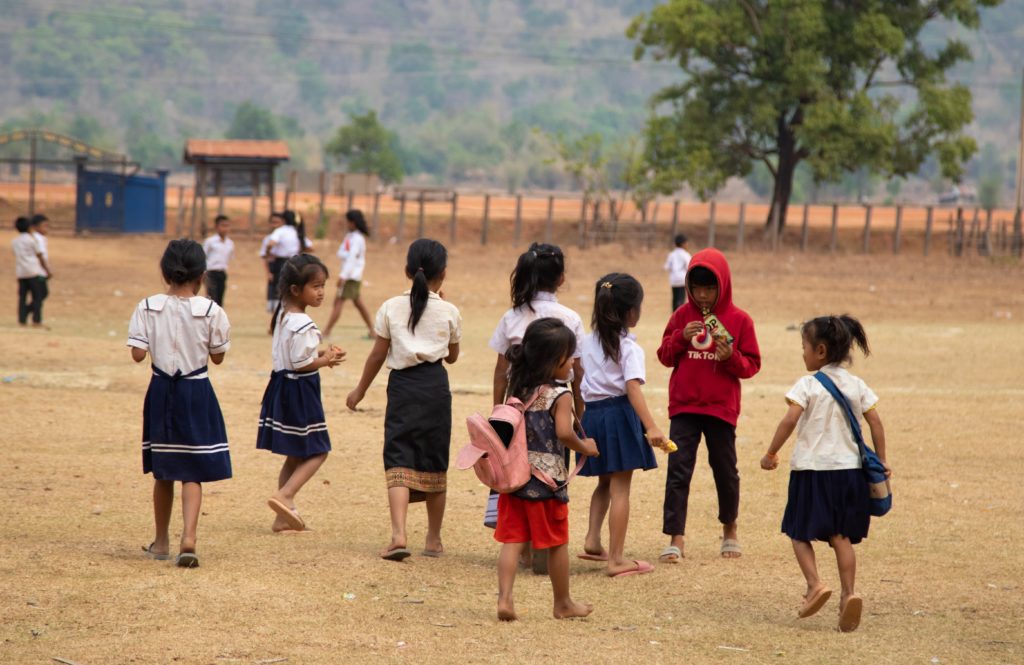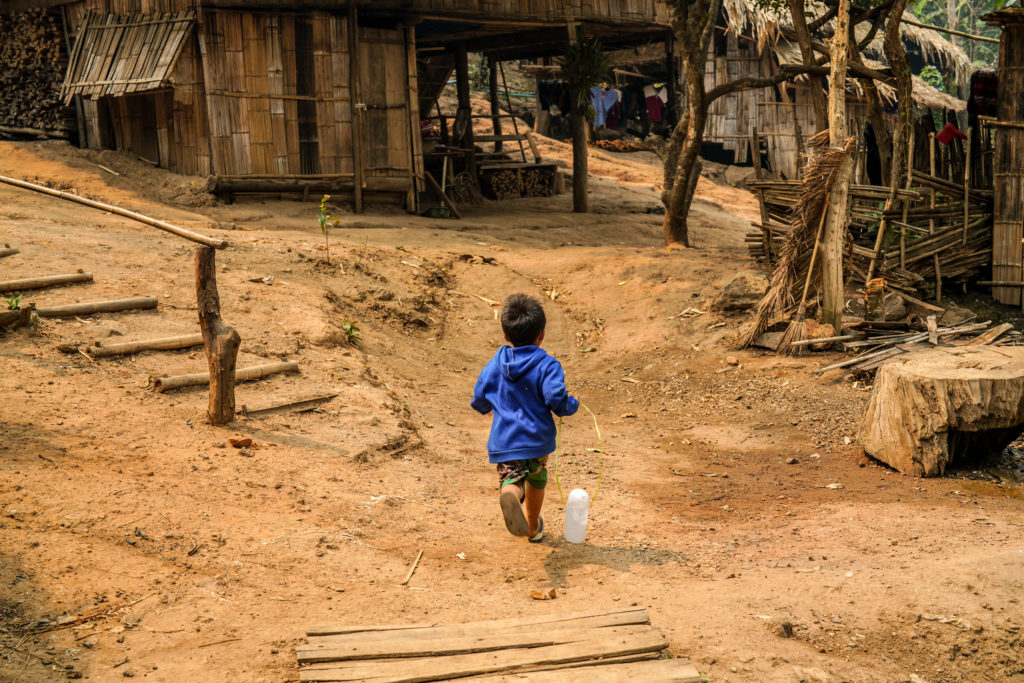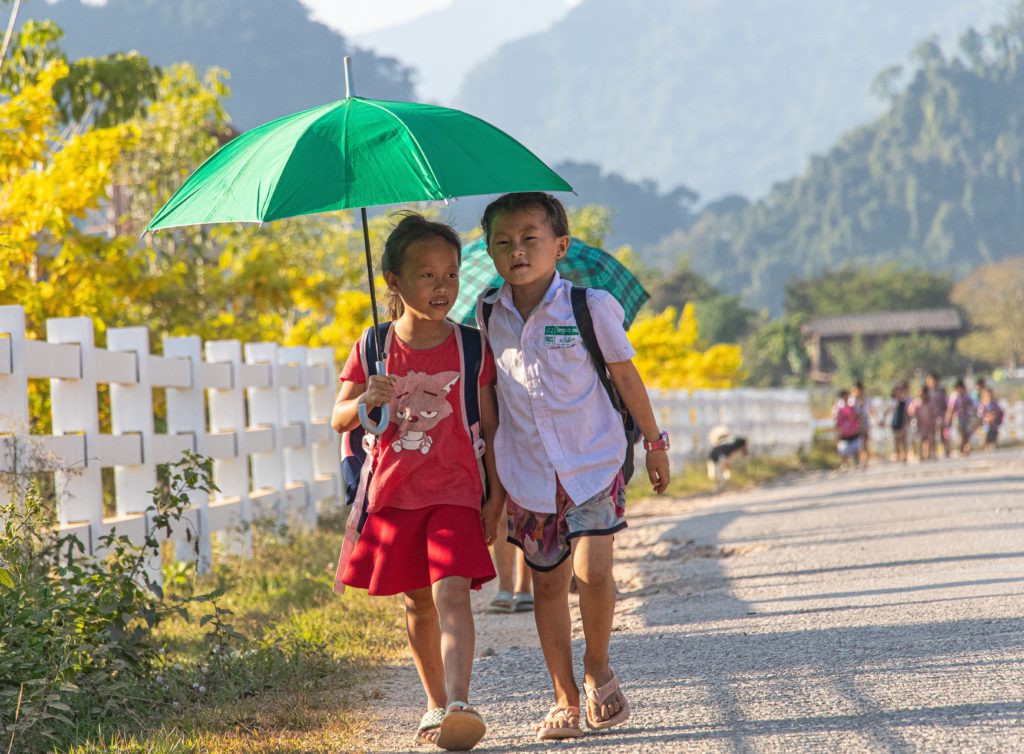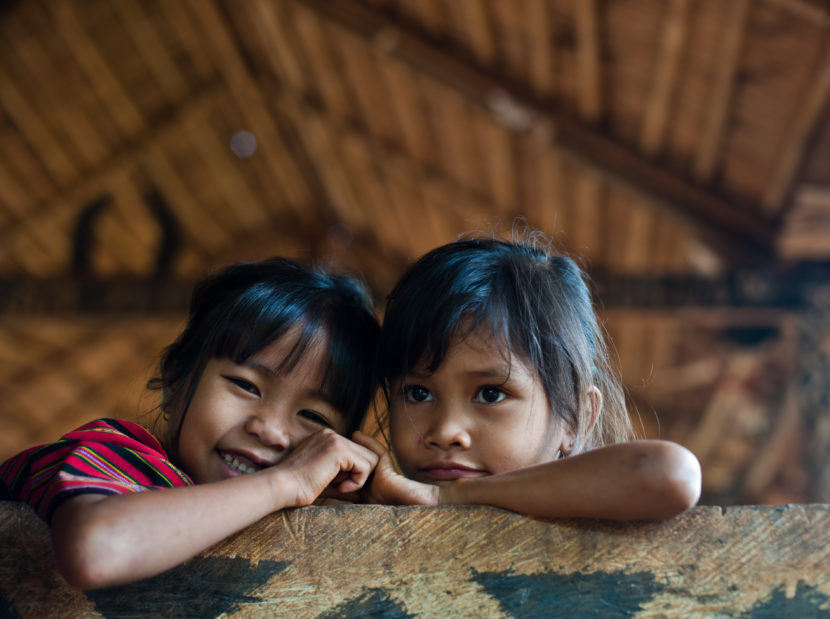While the Vietnam War ended over 50 years ago, remnants of unexploded ordnances (UXO) buried across rural areas continue to injure and kill children in Laos and Cambodia. These hidden explosives are found near homes, schools, fields, and forests, making everyday activities like playing, farming, or collecting water potentially fatal. Their impact goes beyond physical harm as UXOs disrupt access to education, healthcare, and safe spaces — violating children’s rights and hindering community development.
Tracing the UXO threat back to the Vietnam War
Between 1964 and 1973, the United States left behind thousands of unexploded ordnances (UXOs) in Vietnam, Laos and Cambodia (Suthinithet, 2010). UXOs are explosive weapons, such as grenades or cluster munitions that did not explode when they were deployed but continue to pose a risk of detonation (UNDP, 2009). To disrupt the flow of troops from North Vietnam to the South, the U.S. heavily bombed the Ho Chi Minh Trail, a critical supply route that passed through neighbouring Laos and Cambodia (Rotondi, 2025).
Approximately one third of the explosives dropped never detonated when they were launched, leaving over 800,000 UXOs behind (Hendrickson, 2023). Today, these explosives have become buried beneath the soil, overgrown by vegetation, or hidden by changing landscapes making them hard to detect and a deadly threat for unsuspecting bystander.
A playground turned battleground
Even decades after the Vietnam War, children in Laos and Cambodia are still being injured and killed by unexploded bombs — often during everyday activities. One morning on a school holiday in Nambak District, Laos, a 4-year-old Namneung explored the forest to dig for bamboo shoots.
While exploring the area, she found a small round object that looked like a baseball. She picked up what looked like a toy, unaware it was a bomb. When it exploded, she was seriously injured. Villagers rushed her to the nearest hospital by motorbike, a journey of over two hours.
Namneung survived after receiving emergency care, but she permanently lost vision in her left eye. Her story remains a painful reminder of how the dangers of war continue to affect children decades later (FWAB, n.d.).
The ongoing impact of UXOs on daily life in Laos and Cambodia

Sadly, Namneung’s story is not uncommon in rural areas of Laos and Cambodia. Rural communities in Laos and Cambodia continue to face ongoing danger from UXOs (NRA, 2022). These threats are found in fields, forests, borders, schools, homes, and near other essential infrastructure making it hard for families to work, access food, water, and other necessities. Limiting their freedom to move safely, these dangerous remnants of war disrupt daily lives often preventing children from playing outside or going to school.
Injuries from UXOs are often devastating, especially for children, whose smaller bodies are more vulnerable to the force of blasts. Common injuries include traumatic amputations of limbs, severe burns, internal injuries, loss of eyesight or hearing, and brain injuries. Many survivors require multiple surgeries, prosthetic limbs, and long-term rehabilitation.
Why children are most at risk from UXOs
Children living in rural areas of Laos and Cambodia are threatened by UXOs daily. Whether playing, herding animals, collecting water, or working with their families, they may unknowingly come into contact with hidden explosives. Cluster munition remnants are particularly deadly for children who are prone to pick them up thinking they are harmless toys.
How UXOs violate international law and children’s rights
Explosive weapons like landmines and cluster bombs go against international laws designed to protect children. The Convention on the Rights of the Child, which was ratified by both Laos and Cambodia in 1991 and 1992, respectively, says every child has the right to life, safety, and protecting from violence (United Nations General Assembly, 1989). However, in Laos and Cambodia, many children still live in daily danger from leftover bombs, unable to safely attend school or access healthcare.
The Mine Ban Treaty (Ottawa Treaty, 1997), as an international agreement, prohibits the use, production, and transfer of anti-personnel landmines, and requires states to clear contaminated areas and assist victims (United Nations, 1997). In addition, the Convention on Cluster Munitions (2008) bans the use, stockpiling, and transfer of cluster bombs, and obligates states to support victims and clear affected land (ICRC, n.d.).

For countries like Laos and Cambodia, which are among the most heavily contaminated by cluster munitions in the world, this treaty is a vital framework for addressing the long-term humanitarian and development consequences of war. Cambodia ratified the Mine Ban Treaty in 1999, committing not just to ban landmines but also to clear contaminated land and support survivors. Laos has not joined this treaty. Conversely, Laos signed and ratified the Convention on Cluster Munitions in 2008–2009, legally committing to ban and clear cluster munitions. Cambodia, however, has not yet acceded to this convention
Challenges in upholding international commitments
UXOs don’t just harm bodies, they rob children of their right to play, to learn and to grow up safely. For many, fear of UXOs keeps them out of school. For those injured, recovery is often hindered by poverty, stigma, and lack of resources (UNDP, 2009). This ongoing hidden threat violates children’s fundamental right to life and protection from violence and harm, as children living in contaminated areas face daily risks of injury or death.
UXOs also restrict their rights to play and grow up in a safe environment, as outdoor spaces become dangerous rather than nurturing. The right to education is frequently compromised when fear or the physical presence of explosive remnants near schools prevents children from attending.
For children who are injured, the right to health and rehabilitation becomes critical, yet access to medical care and long-term support is often limited in remote or under-resourced areas. Additionally, the right to inclusion and support for children with disabilities is frequently overlooked, with many survivors facing social stigma, limited access to assistive devices, and exclusion from school or community life.
Responding to the threat of UXOs
In response to the ongoing threat of UXOs, a combination of strategies has been implemented to reduce risks, support survivors, and accelerate land clearance (Allman, 2015). In Laos, the National Regulatory Authority works with organizations to locate and destroy UXOs. In Cambodia, the Cambodian Mine Action Centre trains and supports deminers across the country. Government and non-profit organizations also focus on education, rehabilitation, and innovative detection methods (ESCAP, 2021).
Educating children about UXO dangers
Risk education is one of the most vital tools in preventing injury and death from UXOs (UNDP, 2009). In communities located near high-risk or yet-to-be-assessed areas, especially in rural Laos and Cambodia, educational programmes are delivered through schools, community centres, and outreach activities.
These programmes aim to teach school-aged children and community members how to recognise dangerous items, avoid suspicious areas, and report them to the authorities. In high-contamination zones, risk education has proven to significantly reduce accidents, especially among children who are otherwise most at risk due to a lack of awareness.
Supporting UXO survivors
For those who have already been affected by UXOs, rehabilitation is essential. Medical treatment, prosthetic limb provision, and psychosocial counselling are delivered through a mix of national programmes and internationally funded projects (UNDP, 2009). Children often require emergency surgery followed by long-term physical therapy and support to regain mobility and independence.
Even though the services are provided free of charge, the victims from remote areas do not have the ability to reach the centres. To respond to this challenge, mobile rehabilitation units and local outreach workers have been deployed in some regions.
Innovative strategies in UXO detection
Innovative solutions are accelerating land clearance, with mine-detecting rats and trained dogs helping detect buried explosives safely and efficiently (APOPO, 2025). These animals can search large areas more quickly than humans with metal detectors and are playing an essential role in making land safe for use again.
African giant pouched rats are highly effective in open terrain, covering large areas without triggering mines, while dogs excel in pinpointing explosives in high-priority zones like paths or villages. Working alongside human deminers, they complement each other’s strengths and enable quicker surveying of hazardous areas. This not only saves time and resources but also speeds up the return of land for farming, schooling, and daily use, reducing risks to civilians, especially children.
Progress and hope in UXO-affected communities
While war may be over, its remnants continue to put the lives of children in Laos and Cambodia at risk. The path to recovery is long, but through education, rehabilitation, innovation, and international commitment, a safer future for the next generation is possible.
With the support of international donors and national agencies, demining programmes in Laos and Cambodia are saving lives. Yet, the need still far exceeds the resources. Many contaminated regions remain uncleared, and thousands of survivors still lack the support they need to heal.”
The lives of children shouldn’t be determined by where they step or what they touch. Every child deserves a safe place to play, learn, and grow — without fear of invisible bombs buried in the ground. With greater awareness, international cooperation, and local empowerment, we can finally bring an end to this silent threat.

Humanium continues to advocate for the elimination of explosive remnants of war, the protection of children in conflict-affected areas, and the rehabilitation of survivors of UXO-related accidents. You can support this mission by volunteering, sponsoring a child, or donating . Together, we can reclaim safe ground — one step at a time.
Written by Kathleen Tereposky
Bibliography:
APOPO. (2025). What we do. Retrieved from APOPO at https://apopo.org/what-we-do/detecting-landmines-and-explosives/, accessed on July 9, 2025.
Danae Hendrickson. (2023). Lessons This Bomb Filled Land is Teaching Me. Retrieved from Legacies of War at https://www.legaciesofwar.org/post/lessons-this-bomb-filled-land-is-teaching-me, accessed on June 23, 2025.
ICRC. (n.d.). (2008). Convention on Cluster Munitions. Retrieved from ICRC at https://www.icrc.org/en/document/2008-convention-cluster-munitions, accessed on June 23, 2025.
Jessica Pearce Rotondi. (2025). Why Laos Has Been Bombed More Than Any Other Country. Retrieved from Legacies of War at https://www.legaciesofwar.org/articles/why-laos-has-been-bombed-more-than-any-other-country, accessed on June 23, 2025.
National Regulatory Authority (NRA) for UXO/Mine Action in Lao PDR. (2022). UXO Sector Annual Report 2021. Retrieved from NRA at http://www.nra.gov.la/resources/AnnualReports/English/UXO%20Sector%20Annual%20Report%202021.pdf, accessed on June 23, 2025.
Santi Suthinithet. (2010). Land of a Million Bombs. Retrieved from Legacies of War at https://www.legaciesofwar.org/articles/land-of-a-million-bombs, accessed on June 23, 2025.
TD Allman. (2015) Laos Finds New Life After the Bombs. Retrieved from National Geographic at https://www.nationalgeographic.com/magazine/article/laos-recovery-unexploded-ordnance-vietnam-war, accessed on June 23, 2025.
United Nations Development Programme. (UNDP). (2009). Hazardous Ground: Cluster Munitions and UXO in the Lao PDR . Retrieved from UNDP at https://www.undp.org/sites/g/files/zskgke326/files/migration/la/UNDP_LA_Hazardous-Ground.pdf, accessed on June 23, 2025.
United Nations Economic and Social Commission for Asia and the Pacific. (ESCAP). (2021). Lao PDR’s 2nd VNR-FINAL SDGs Report. Retrieved from Legacies of War at https://www.legaciesofwar.org/articles/lao-pdr’s-2nd-vnr-final-sdgs-report-, accessed on June 23, 2025.
United Nations General Assembly. (1989). Convention on the Rights of the Child. United Nations, Treaty Series, vol. 1577 at art 6. Retrieved from the United Nations Office of the High Commissioner for Human Rights at https://www.ohchr.org/en/instruments-mechanisms/instruments/convention-rights-child, accessed on June 23, 2025.
United Nations. (1997). Convention on the Prohibition of the Use, Stockpiling, Production and Transfer of Anti-Personnel Mines and on Their Destruction. United Nations, Treaty Series, vol. 2056. Retrieved from the United Nations Office of Disarmament Affairs at https://www.un.org/disarmament/anti-personnel-landmines-convention/, accessed on June 23, 2025.


